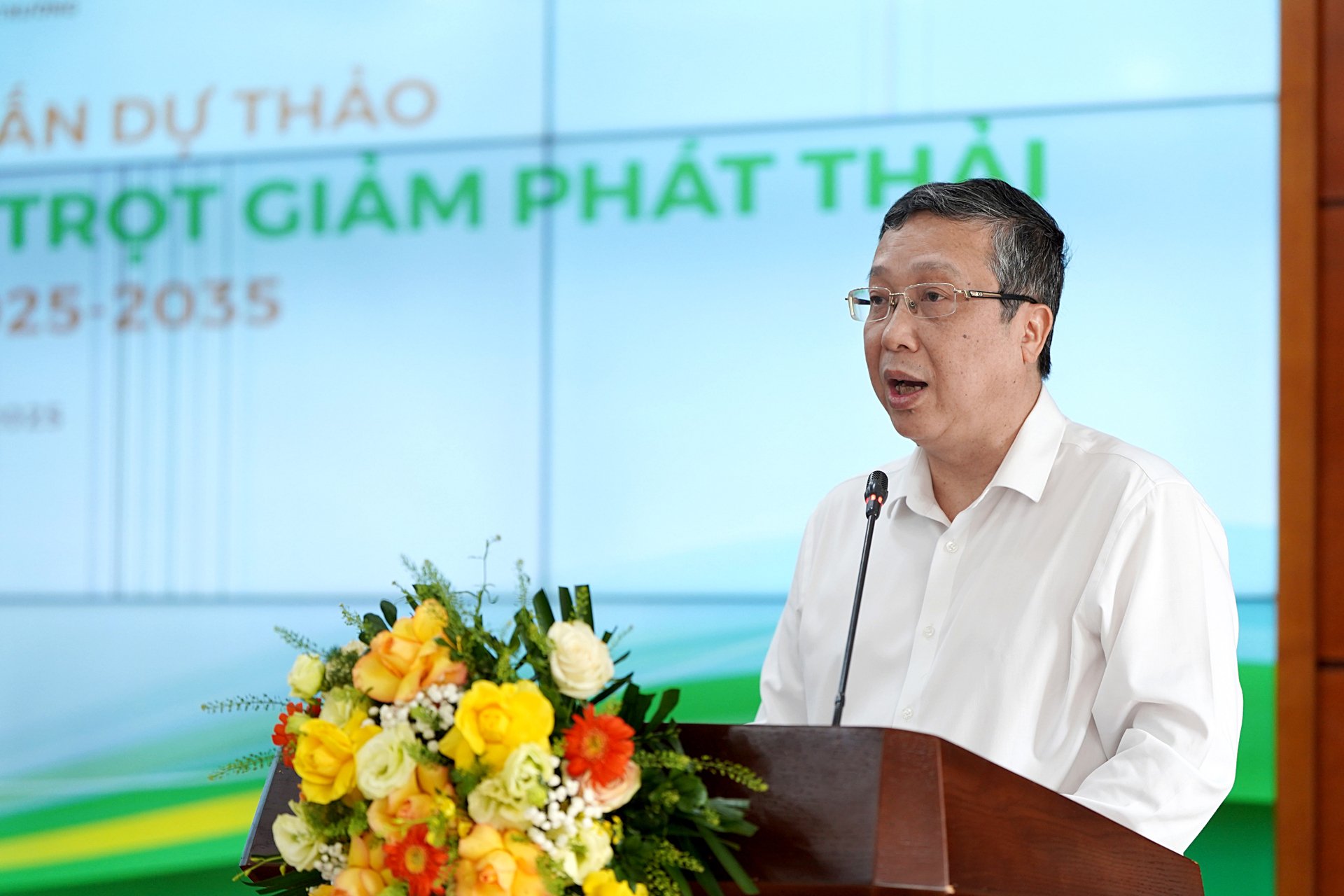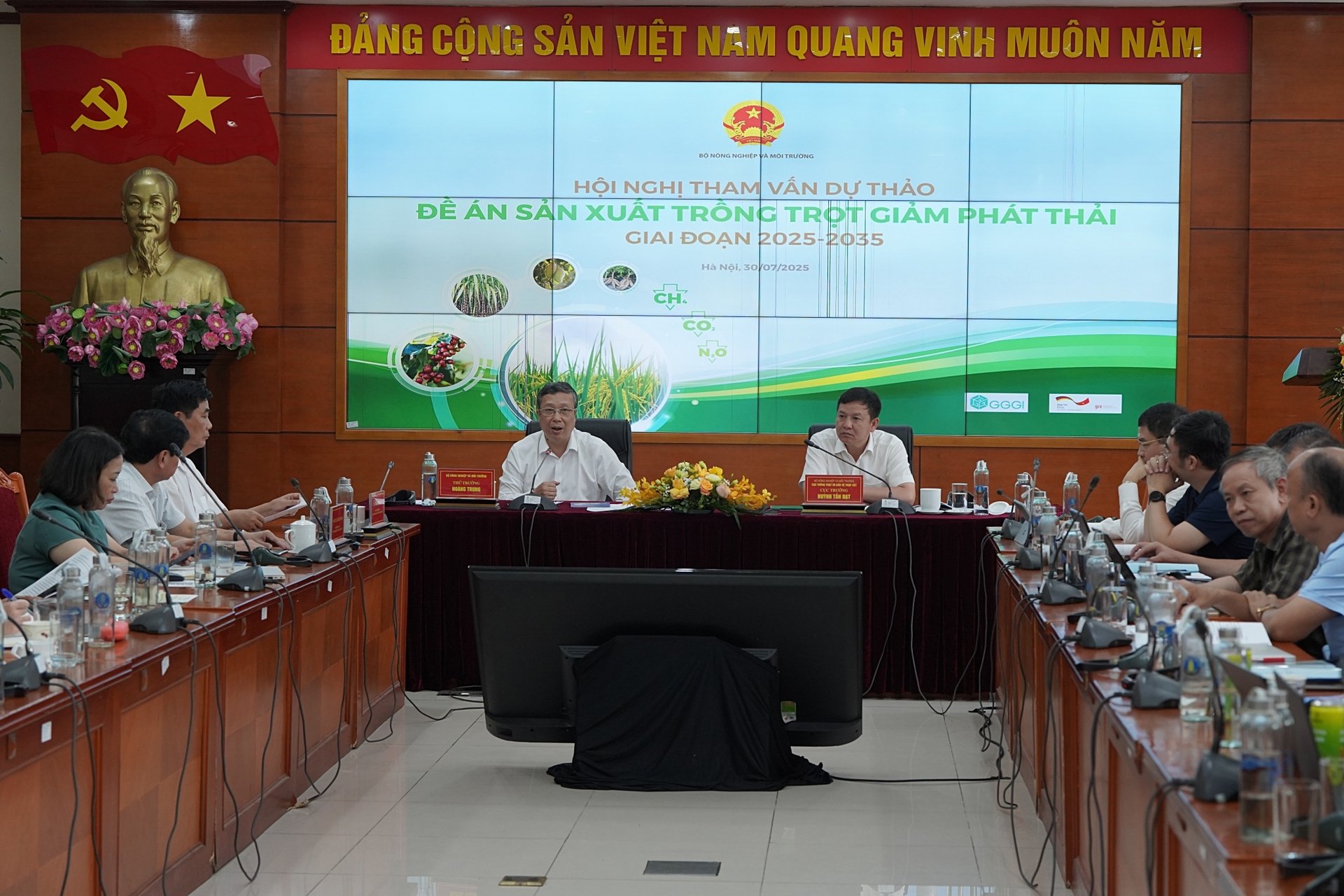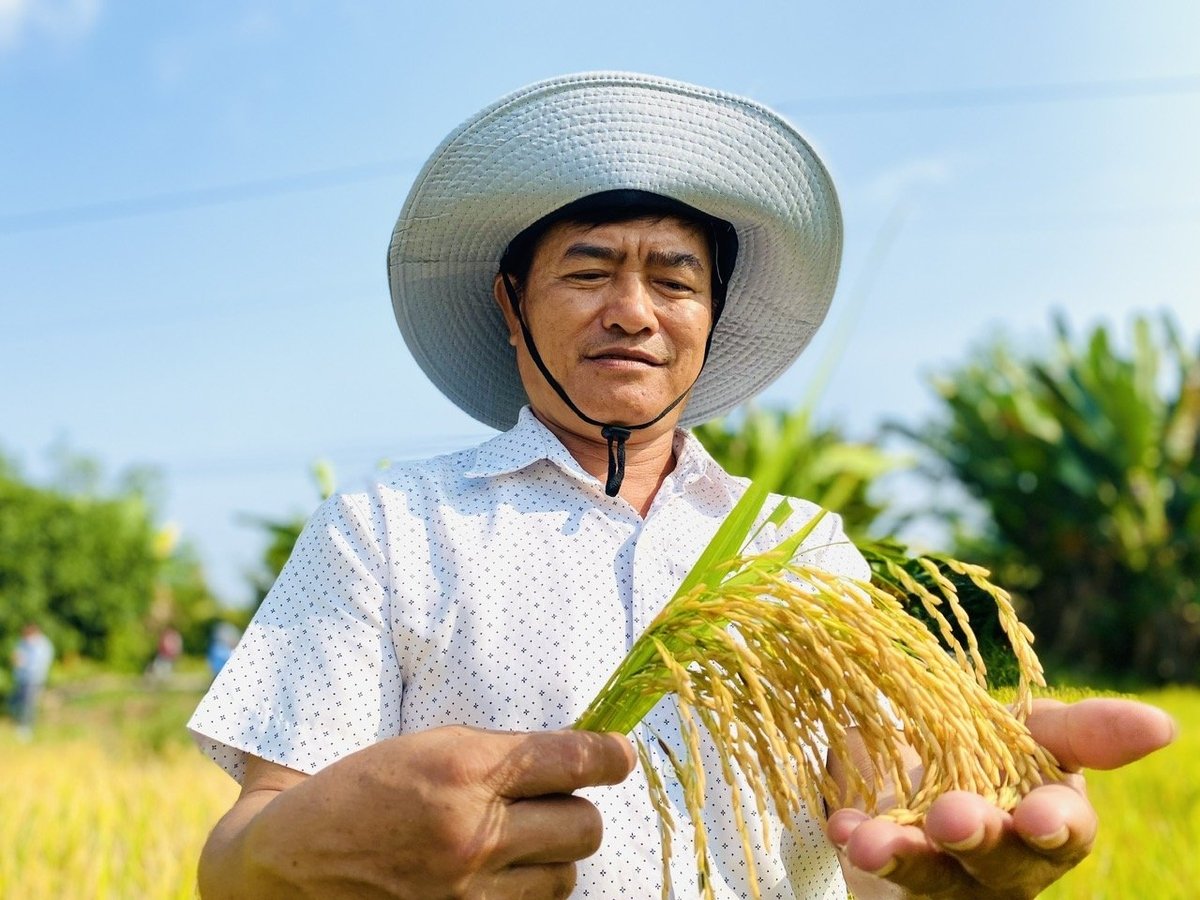October 5, 2025 | 12:57 GMT +7
October 5, 2025 | 12:57 GMT +7
Hotline: 0913.378.918
October 5, 2025 | 12:57 GMT +7
Hotline: 0913.378.918
Addressing the consultation workshop on the Draft Proposal for Low-Emission Crop Production held on the morning of July 30, Deputy Minister of Agriculture and Environment Hoang Trung emphasized that transitioning to low-emission farming models is not only an urgent necessity but also a strategic driver for increasing value-added and enhancing the reputation of Vietnamese agricultural products in global markets.
“Crop production is a major source of emissions, but it also holds the greatest potential for emission reductions - if properly organized and guided,” he said.

Deputy Minister Hoang Trung called for the participation of all stakeholders in the development and implementation of the proposal. Photo: Bao Thang.
According to 2020 statistics, Vietnam emitted approximately 454.6 million tons of CO₂ equivalent, with the agriculture sector alone accounting for over 116 million tons, and rice cultivation contributing as much as 77 million tons. With emissions growing at nearly twice the rate compared to 2010, Deputy Minister Hoang Trung warned that, without timely action, the country’s total emissions could reach 1 billion tons of CO₂ by 2030.
A new proposal, led by the Ministry of Agriculture and Environment (MAE), sets a target to reduce emissions in the crop production sector by at least 10% by 2030 - equivalent to around 6–8 million tons of CO₂. To achieve this goal, the draft plan will focus on major high-emission crops such as wet rice, maize, black pepper, coffee, dragon fruit, bananas, citrus fruits, and long-term industrial crops.
Deputy Minister Hoang Trung stated that a range of technical solutions has been proposed, including crop restructuring, development of new cultivation technology packages, use of biochar, improved agricultural inputs, by-product processing, and enhancement of soil health. He emphasized: “We are not short of solutions; the key is selecting the right ones that are practical, scalable, and can be rapidly replicated both nationally and at the farm level.”
In addition, the measurement, reporting, and verification (MRV) system and the emissions database have been identified as critical components. Vietnam must develop an MRV system suited to its small-scale, fragmented production conditions, while also being compatible with international standards. This will support the certification of low-emission products and participation in carbon credit trading.
The Ministry also expressed high expectations for the establishment of a comprehensive policy framework to encourage green production among both businesses and farmers. A blended financing approach, drawing on state budget, private sector, and international sources, is seen as a core element for ensuring the proposal’s feasibility. In this effort, cooperatives and value chain linkages are considered essential to scaling up low-emission farming models.

The conference drew the attention of hundreds of delegates attending both in person and online. Photo: Bao Thang.
In the long-term vision, the Low-Emission Crop Production Proposal represents a concrete step toward implementing Vietnam’s international climate commitments, including the pledge to achieve net-zero emissions by 2050, as announced by Prime Minister Pham Minh Chinh at COP26.
To bring the proposal into reality, the MAE is calling for intellectual contributions from scientists, domestic and international experts, as well as representatives from businesses, local authorities, and practitioners of agricultural production models. “We hope this will not remain just a plan on paper, but evolve into a strategic action program for Vietnam’s crop production sector over the next decade,” Deputy Minister Trung emphasized.
One of the key tasks of the proposal is to restructure Vietnam’s crop production sector in alignment with climate conditions and market demands. According to Deputy Minister Hoang Trung, the most important goal of the plan should be to transform farming practices in order to improve efficiency, increase farmers’ incomes, and simultaneously adapt to climate change while promoting sustainable development. Therefore, the scope should not be limited to a few specific crops, it must open up space for the entire crop sector, encouraging localities and businesses to take the initiative and innovate.
“We need to reorganize the production system through integrated solutions: technical, institutional, and market-based. Low-emission farming must be considered a strategic pathway for restructuring the crop sector,” he said. He also suggested prioritizing a shift toward perennial crops with carbon sequestration potential, and developing high-value vegetables and flowers on former rice-growing land. These are all models with clear potential for emission reduction.
He emphasized the need to develop tailored technical packages for each crop group and ecological region, with an initial focus on five major crops: rice, cassava, coffee, sugarcane, and banana. These crops are vital to livelihoods but also pose high emission risks if not properly managed.
Deputy Minister Hoang Trung stressed that establishing a complete set of technical standards and a robust MRV system is a “prerequisite” for demonstrating emission reduction outcomes, participating in the carbon credit market, and building a credible low-emission agricultural brand for Vietnam.
In addition, he highlighted the importance of developing sustainable value chains, such as organic and circular agriculture, that link emission reduction with added product value. “This is the foundation for Vietnamese products to carry low-emission labels and penetrate premium markets,” he suggested, while also calling for serious investment in training and communication to shift mindsets, considered a critical condition for the proposal’s success.

Low-emission rice farming helps reduce costs and increase profits. Photo: Le Hoang Vu.
In terms of overarching solutions, the Proposal should focus on several key pillars: strengthening international cooperation; building a low-emission agricultural brand linked to traceability and market access; and institutionalizing the State’s coordinating role through mechanisms that blend budget resources, integrate national target programs, and establish a comprehensive monitoring and evaluation system.
Concluding his remarks, Deputy Minister Hoang Trung urged the lead drafting unit to finalize the Proposal by August 2025 for submission to the Ministry for approval. He also emphasized the need for concrete implementation plans tailored to specific crops, regions, and target groups.
“The transition to low-emission crop production is our responsibility today - to farmers, to the environment, and to future generations,” he stressed.
The MAE envisions the Proposal as a foundation for developing a low-emission agricultural ecosystem - where the government leads with enabling policies, businesses invest in technology, farmers are the key agents of transformation, and international partners provide essential support.
“I hope to continue receiving close cooperation from local authorities, international organizations, scientists, businesses, and farmers in building a crop production sector in Vietnam that is sustainable, responsible, and reputable on the global stage,” Deputy Minister Hoang Trung affirmed.
Translated by Phuong Linh

(VAN) The Department of Climate Change (Ministry of Agriculture and Environment) held a conference lately this week to discuss the topic ‘Implementing Viet Nam's Commitments at the COP26 Conference’.

(VAN) The Ministry of Agriculture and Environment has signed Decision No. 4024, approving the 'Low-emission crop production project for 2025-2035, with a vision to 2050'.

(VAN) The People’s Committee of Nghe An Province had requested measures to protect marine mammals to avoid the risk of being “flagged” by trade partners.

(VAN) To date, the system of legal documents regulating sustainable forest management and sustainable forest management certification has been increasingly improved, basically meeting practical requirements.

(VAN) The draft policy on soil health is regarded as an important step forward, contributing to a more comprehensive approach to soil quality management.

(VAN) Concerted and resolute actions taken in recent times have affirmed Viet Nam as a responsible and proactive partner, ready to work with the EU towards a transparent fisheries sector.

(VAN) A policy study indicates that Viet Nam will be able to meet its national greenhouse gas (GHG) emission reduction targets by retaining 50% of the total carbon credits during international transactions.